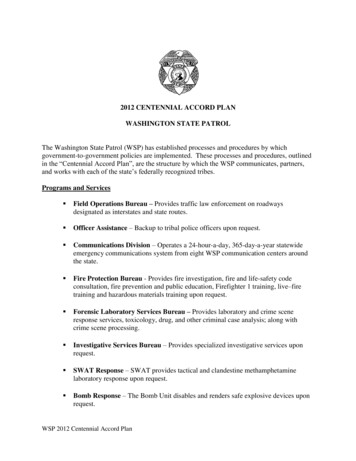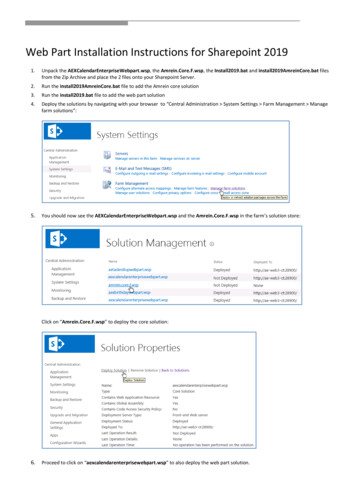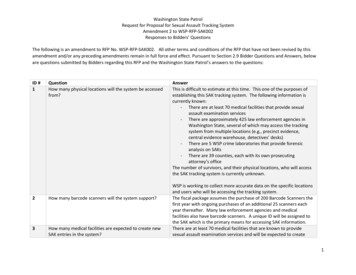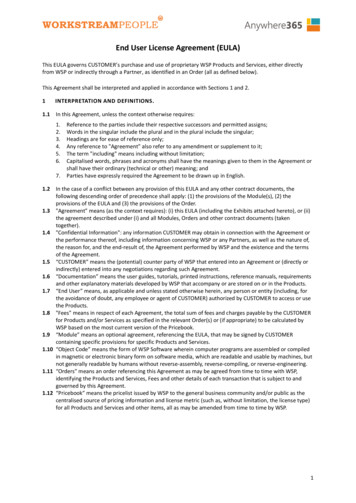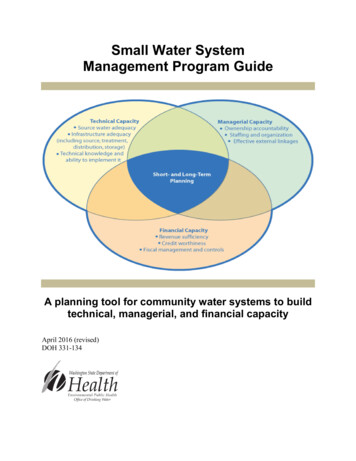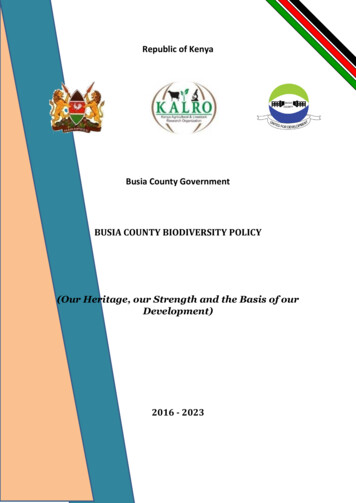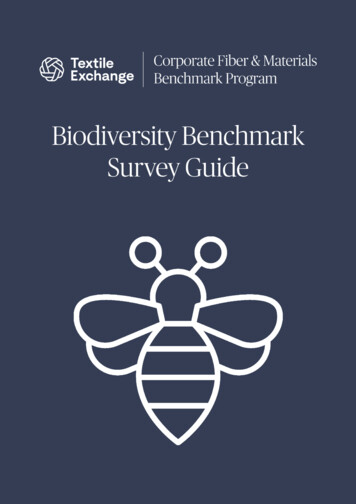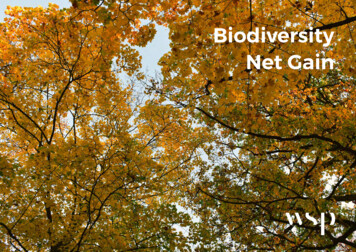
Transcription
BiodiversityNet Gain
WSP's 'win-win' guide to Biodiversity Net GainIn this toolkit, we’ll guide you through BiodiversityNet Gain or BNG and show why it is a ‘win-win’proposition for the environment and fordevelopers.The Westminster government has confirmed thatit will use the forthcoming Environment Bill tomandate BNG for development in England. OtherUK countries may also choose to legislate over thenext few years.To find out more, or for help in developing abespoke plan, talk to us.The sooner you begin, the quicker you – and theenvironment – start to gain.1What is BNG?2Why does it matter?3Who uses BNG?4BNG for developers5Be inspired6The BNG maths7Top Tips8Get in Touch
1What is BNG?BNG is an approach to development that leaves the natural environment in a measurably better statethan it was initially. The outcome is a net gain in biodiversityThe system of ‘biodiversity units’ used to measure biodiversity before and after site developmentis a quantitative assessment, demonstrating the change in biodiversity in a robust, consistent andtransparent way.Net LossNo Net LossNet GainIt is important to remember that quantifying biodiversity in units is just one piece of the puzzle andthe BNG Good Practice Principles developed by CIRIA, CIEEM and IEMA must be followed for a projectto claim BNG. These ten principles set out good practice for achieving BNG (i.e like-for-like habitatcompensation).
2Why does it matter?Biodiversity matters. The variety oflife on Earth has intrinsic value and ishugely valuable to the economy andour wellbeing. The air we breathe, thewater we drink, and the foodwe eat, all rely on biodiversity. Plantsclean the air and bees pollinate foodcrops, for instance.Worldwide, governments and regulatorsare backing the use of BNG as a toolto help to mitigate the impact ofdevelopment on biodiversity. Over 100countries have a policy relating to BNGand in some countries it is mandatory.
3Who uses BNG?At present, BNG is mostwell-known as a lever forachieving greaterbiodiversity in developinginfrastructure projects suchas roads, railways, airports,and power generationfacilities.Although it is not yetmandatory in all parts ofthe UK, the Westminstergovernment will use theforthcoming EnvironmentBill to mandate BNG andsome developers havealready adopted BNGvoluntarily, with greatsuccess.The general consensus isthat the economic andreputational benefitsoutweigh any costs.The UK government’snewly-launched 25-yearenvironment plan isfocused on achievingbiodiversity net gainthrough development.Hover your cursor over the organisation name to see the commitments which havebeen made in the infrastructure sector: Scottish and Southern Electricity Networks (SSEN) Highways England Network Rail Infrastructure Projects Berkeley Group Transport for London National GridLocal Authorities are setting policies and strategies requiring BNG from development: District and County Councils
4BNG for developersSome developers have beentaking a BNG approachvoluntarily.It is easier and morecost-effective to protectbiodiversity on developmentsites from the outset, thanto start when an issuerelated to biodiversity isidentified.The more developmentsthat benefit from a BNGapproach, the morethe developer – and theenvironment – stand togain. If you are a UK land orproperty developer, clicksome of the buttons to seewhat you could gain.This is the win-win: forbusiness and biodiversity.162534
5BNG Win-Win. Be Inspired.The benefits of BNG – strategically or at project level – all represent ‘win-win’ for the developerand biodiversity, Check out our project case study and our strategic case study.Project ScaleStrategic / City ScaleWins for developer: Ability to report transparently on biodiversitylosses and gainsStrategic / city scale offers the all the same wins asthe project scale AND the following EXTRA wins! Understanding of habitat compensationrequirements in the design stages Understanding of the biodiversity value oflandholdings Potential cost savings Opportunity to deliver more biodiverse greenspaces – great for people and wildlifeTime and cost savings resulting from strategicapproach (economies of scale/ synergies) Understanding of how and where to compensatefor any adverse biodiversity impacts withinlandholdingsAdditional wins for developer:Win for biodiversity: More habitats for wildlife / protected speciesAdditional wins for biodiversity: Like for like habitat compensation – for example,not replacing a woodland with a grassland (uselessfor species who lived in the woodland) See our case study for more informationConnectivity of habitats (resulting from havingan overview of biodiversity requirements withinlandholdings)Wins for society:Cleaner air Improved health and wellbeingBeautiful places to live and work More connection to nature See our case study for more information
6The BNG mathsBiodiversity assessments are based on following the BNG Good Practice Principles. One of these principlesis to make measurable change in biodiversity. Assessing this change is predominantly based on a metricdeveloped by Defra (first published 2012, a new version was published in July 2019). To understand thefollowing example calculation, you’ll need to know the following definitions:Factors used to describe the habitat and itsbiodiversity Distinctiveness:A collective measure of biodiversity,includes parameters such as number andvariety of species and their rarity. Condition:The quality of a habitat. For example, apoor quality habitat may be degraded asa result of pollution, erosion, or invasivespecies. Strategic significance:How closely the habitat is aligned tolocal and national strategic priorities forbiodiversity. Connectivity:The size and distribution of patches ofhabitat, and how easily typical species canmove between them.Factors used to describe the risks associatedwith enhancing or creating a habitat Spatial risk:In delivering compensation for habitatloss, the further a habitat is recreated isfrom the site of the loss, the greater therisk. Delivery risk:The level of difficulty involved in creatingor restoring habitat. Temporal risk:To what extent the timing ofcompensation delivery could result in atemporary loss of biodiversity. This riskincludes the time it takes for a habitat toreach its target condition.Each factor is given a numeric value to allow a biodiversity score to be calculated for the baseline orstarting point and then calculated for the habitats proposed at the end of the development. These twoscores can be compared with one another and if the post development score is greater than the baselinescore the development will be able to deliver a net gain in biodiversity.The metrics must be used in combination with qualitative information, such as detail about the animalsthat use a site, and the wider ecological network. With that in mind, here is how the numbers work:
The BNG maths12Pre-development (existing habitat)Post-development (new habitat)HABITAT PARCELHABITAT PARCELSize (ha)Size (ha)BIODIVERSITY QUALITYBIODIVERSITY onConnectivityRISK FACTORDifficultyto CreatePre-developmentDistancefrom sitePost-developmentBiodiversity Units3Time untilTargetConditionBiodiversity UnitsOutcomeNet LossPost-developmentBiodiversity UnitsPre-developmentBiodiversity UnitsNo Net LossNet Gain
7Getting Started: Our Top TipsIf you are ready to implement a BNG approach,these are the things to think about:1. Start early:Understanding the opportunities on yoursite is a prime route to ‘win-win’ – you savetime and money because it is easier toprotect biodiversity from the outset, andwildlife benefits because the sooner youstart, the less of its habitat is lost.2. Build BNG into existing process:By combining BNG principles with anEnvironmental Impact Assessment, forexample, you can gain more for very littleextra effort. Taking a BNG view,may enhance your ecological assessment –again, it’s ‘win-win’.3. Always apply the mitigation hierarchy:Avoiding and minimising impact onbiodiversity is most often much cheaperthan compensating for it, and it is the bestthing for wildlife.4. Follow the CIRIA, CIEEM and IEMA* goodpractice principles:These are the cornerstones of BNG.5. Appoint professionals:Their advice will help you identify the mostproductive and realistic ways to achieveBNG, saving you money overall, and theirexpertise will benefit wildlife on site.6. Deliver multiple objectives:Deliver gains in biodiversity along sidework to meet other objectives, for exampleproviding sustainable urban drainage(SUDs) that also enhance biodiversity.7. Engage your stakeholders:Local authorities, local communities andgovernment agencies tend to respondpositively to projects that protectbiodiversity – speak with them early – itmay help move your project through theplanning system.8. Publicise your BNG work:It will enhance your reputation andencourage other developers to follow yourlead.* CIRIA (Construction Industry Research and Information Association)CIEEM (Chartered Institute of Ecology and Environmental Management)IEMA (Institute of Environmental Management and Assessment).
8To 'win-win' get in touchAll our ‘top tips’ represent a ‘win-win’ for developers and biodiversity – so it makes good business senseto get started, especially if you’re in England where BNG will become a mandatory part of the planningprocess!If you would like an update on the latest BNG news, or advice on how legislation might affect yourdevelopment plans, please get in touch. We’ll be glad to help. We have a team of over 150 professionalecologists, including a dedicated team of biodiversity specialists.Key contacts (click name to hardsSarahScott
Scottish Hydro Electric Transmission plc (SHE Transmission)We have supported SHE Transmission todevelop a BNG toolkit to embed biodiversityconsiderations into project planning,optioneering and on-site delivery. WSP have alsosupported SHE Transmission in undertakingBNG calculations for a number of projectsincluding their Spittal Substation which is partof the wider Caithness-Moray HVDC transmissionproject.SHE Transmission have turned a biodiversitynet loss, into a net gain by modifying theirlandscape plans to include more species-richplant mixes. This change has resulted in anincrease in important habitat for one of the UK’srarest bumblebees – the Great yellow (Bombusdistinguendus) – and delivers on the ScottishGovernment’s Pollinator Strategy.Credit: SHE TransmissionCredit: Great Yellow Bumblebee, Mary Harris
Transport for London, UKFor TfL, we created abiodiversity baseline ofthe habitats within itshighway, rail,overground andunderground estatesand used it to developbespoke toolkits thathelp TfL to calculatebiodiversity units, reporton gains and losses,and track progress oversuccessive years
In delivering compensation for habitat loss, the further a habitat is recreated is from the site of the loss, the greater the risk. Delivery risk: The level of difficulty involved in creating or restoring habitat. Temporal risk: To what extent the timing of compensation delivery could result in a temporary loss of biodiversity. This risk
